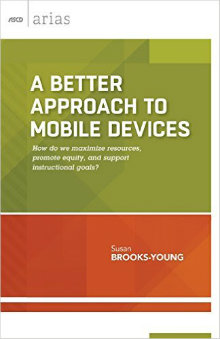A Hybrid Approach to Mobile Devices
A Better Approach to Mobile Devices: How do we maximize resources, promote equity, and support instructional goals?
By Susan Brooks-Young
(ASCD, 2015 – Learn more)

A Better Approach to Mobile Devices by Susan Brooks-Young should be considered a gateway on how to design a Hybrid Mobile Technology Platform in any unique school district setting. Her book offers an abundance of resources, guidelines, and questions to assist in the development of a Hybrid Mobile Technology Program for your local school district.

Hybrid mobile device programs allow districts to tailor resources to the financial, technical, and curricular needs of all local stakeholders. Brooks-Young highlights five key areas to consider during the planning and implementation process:
• connection to curriculum,
• infrastructure and support,
• training and professional development,
• budget, and
• policies and procedures.
The book does an excellent job breaking down each category and providing reflection questions for the reader to consider to help differentiate the needs of their particular learning community.
Specifically, in the training and professional development section, she asks, “Do all staff members have the basic skills required to use the devices provided by the school or district? If not, what basic training topics need to be covered? Are staff members familiar with models for effective technology-supported instructional design?”
This style of tiered questioning allows the reader to reflect and build their own framework of what a mobile device movement may look like in their own educational setting.
The need to move beyond automating tasks
The theme of keeping research at the forefront of any hybrid mobile device program design was echoed throughout the text. This was reinforced in her chapter, “Professional Development in Technology-Infused Instruction.” In this section the author reflects on an Alan November argument from 1997 that stated, “instructional technology has no significant impact on student learning when it’s used just to automate what students would do anyway, with or without technology.”
Brooks-Young uses research from both 1995 (Apple Classrooms of Tomorrow) and 2013 (Project Tomorrow) to confirm the theory that many teachers are still using technology to create automated versions of traditional tasks for students. I have seen educational settings where iPads were simply electronic book bags filled with electronic worksheets as well as chromebooks that were being utilized to collect data from electronic quizzes filled with multiple choice and non high-order thinking tasks.
This will not benefit our students. Instead we need to focus on infusing technology that will help students connect and create knowledge transfer. In an effort to assist the reader, the author offers three resources to help advance the development of authentic instructional practices: the SAMR model, the revised Bloom’s Taxonomy, and the TPAK Framework (venn diagram included).
Managing the tech-infused classroom
An unexpected content covered in A Better Approach to Mobile Devices was a chapter that focused on professional development in classroom management. As we work with technology and adapt our instructional pedagogy and strive to challenge our students with higher order thinking tasks, it is imperative to also adapt the management styles and techniques we implement in our classrooms.
At the conclusion of the chapter the author offers three online resources to assist educators; these resources include the title, brief summary and the hyperlinks.
A concise planning framework
The last four pages of Brooks-Young’s book had me furiously shuffling through previous chapters as I reflected on my own current transitions within my district. These pages include a planning and implementation checklist for the reader to apply to their own setting. The checklist is broken down into the five major content areas of the text discussed above. In other words, the reader is provided with a framework to actively use with their educational team as they build a plan.
A Better Approach to Mobile Devices tactfully combines a four-page implementation checklist, about 16 outside resources to extend knowledge, and over 27 bulleted questions (I did not count the numerous extension questions provided within the paragraphs!) to set the reader up for success. This dynamic approach to an alternate way of thinking about mobile device implementation allows the reader to reflect on his or her own setting and effectively design an approach that will meet the needs of the their students in their unique educational setting.
I applaud Susan Brooks-Young for emphasizing the importance of the types of student tasks teachers provide with technology – and for including tips on how to evolve current classroom practices to enhance the experiences for our students.
_________________
Joshua Zagorski (@JZagorski1) is a K-12 STEM Supervisor. Joshua is currently leading a district initiative to adopt Google Apps for Education and infuse technology to create authentic learning opportunities for all students and teachers. He’s an active member in the NJ Educator Leader Cadre and the NJDOE Math Standards Review Subcommittee, and is on the steering committee for ECET2NJPA. In May 2014 he was selected to attend the Teacher Appreciation White House Social hosted at The White House.



































